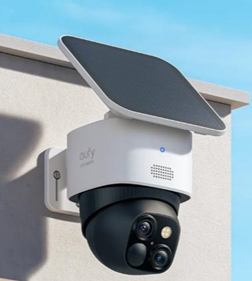reader comments
113
with 72 posters participating
Share this story
Share on Facebook
Share on Twitter
Share on Reddit
The LG Watch Sport.
There's a speaker on the side, but don't expect it to get used for much.
On the other side are big, chunky buttons.
The back is plastic, and you'll find the usual heart rate sensor here. It also comes with a little pin wrench. One of those bottom holes is the microphone.
You can put the wrench on the back of the watch, twist, and it will come off.
With the back off, you can put in an SIM card.
The Watch Sport on the charger.
It looks just like the Moto 360 charger—it's a wirelessly charging watch stand.
USB Type C on the back.
The face isn't much bigger than the Moto 360 2015 (left) and the Huawei Watch (right).
The Watch Sport is a lot thicker, though.
Check out the box, which fits right in with the Google Home and Pixel boxes.
SPECS AT A GLANCE: LG WATCH SPORT
SCREEN
480×480 1.38-inch (348 PPI) P-OLED
OS
Android Wear 2.0 (7.1.1-based)
CPU
1.1GHz Quad-core Qualcomm Snapdragon Wear 2100 (Four Cortex A7 cores)
RAM
768MB
GPU
Adreno 304
STORAGE
4GB
NETWORKING
802.11b/g/n, Bluetooth 4.1, GPS, NFC
SIZE
45.4 x 51.21 x 15.5 mm (1.79 x 2.02 x 0.61 in)
BATTERY
430 mAh

STARTING PRICE
$349 (Euro pricing TBC, but probably ~£350/€400)
OTHER PERKS
Speaker, IP68 dust and water resistance, PPG heart rate monitor,
After more than two-and-a-half years on the market and many minor updates, Google's Android Wear platform is finally getting its first major overhaul: Android Wear 2.0. To celebrate, Google and LG have teamed up to create a pair of smartwatches, the LG Watch Sport and LG Watch Style, as the flagship Android Wear 2.0 devices. The Style is a $250 smartwatch that aims to be as thin as possible (so much so that it doesn't even have a heart rate sensor) but the bigger, more expensive LG Watch Sport is the more interesting of the two.
The $350 Sport packs almost every radio you'd find in a smartphone—LTE, NFC, GPS, Wi-Fi, and Bluetooth. LTE gives it independent access to the Internet, so messages and notifications arrive no matter where you are. NFC makes this the first watch to support Android Pay, so you can walk into a store without a smartphone or wallet, tap on the terminal, and be on your way. GPS means you can leave the house and still have access to Google Maps and run tracking, and with a pair of Bluetooth headphones, you can bring some music along on your jog.
There's a ton of new software, too. Android Wear 2.0 has seen a top-to-bottom overhaul with an all-new UI and a new app development strategy that starts with an on-watch Google Play app store. It has the Google Assistant, a revamp of Google Fit, and even a tiny QWERTY keyboard that works surprisingly well.
When paired with Wear 2.0, the Watch Sport represents a total rethink of Google's smartwatch strategy—it doesn't really need your smartphone any more.
The hardware
The Watch Sport is LG branded, but Google was heavily involved in the development of the device. According to
The Verge
, Android Wear Product Manager Jeff Chang "likened the partnership to Google’s Nexus smartphone program in terms of collaboration and goals." This Google/LG partnership is definitely visible on the box—in addition to being a perfect match for Google's Pixel and Google Home boxes, the box proudly proclaims, "Designed with our friends at Google."
Advertisement
Enlarge
/
The Watch Sport band doesn't bend where you would expect it to. The first inch of the band on both sides is rigid, allowing LG to pack the radio antennas in there. (In this picture, you can also see how much bigger it is than a 2nd gen 42mm Moto 360.)
Ron Amadeo
For a display, the Watch Sport has a 1.38-inch 480x480 (348 PPI) circular P-OLED display covered with Gorilla Glass 3. Inside is a quad-core 1.1GHz Snapdragon Wear 2100 with 768MB of RAM, 4GB of storage, and a 430mAh battery. The design does not seem far off from LG's previous LTE-enabled smartwatch, the troubled
LG Watch Urbane 2
. It's a big, bulky sport watch with a steel body and a permanently affixed rubbery-plastic watch band. The band doesn't come off, because it actually contains the antennas for LTE, Wi-Fi, and the other radios. It's difficult to make all these radios work in a steel case, so stuffing them into a non-metal band is an easy solution.
As a result of the embedded antennas, the band isn't entirely flexible—the first inch of the band on each side is rigid. There is no actual hinge connecting the band to the watch, and the rigid band only starts flexing after the antenna section. It might not fit as snugly on smaller wrists as you would expect.
I'm still not sure if I should really call the LG Sport Watch "too big" or "ugly." It says "Sport Watch" right in the name, and it doesn't look much bigger or uglier than the other
"sport" watches
out there. The 45mm face and 15.5mm thickness fits right in with the rugged sport watches from Casio or Timex, and the LG Sport Watch is downright tiny compared to many of the
G-Shock
watches out there. This device doesn't aim for the "classic" or "luxury" look of the Apple Watch, Moto 360, and Huawei Watch. It's not my style—I prefer the classic look—but this is apparently someone's style. It's a shame that we're stuck with only this look, since the watch band isn't removable.
Enlarge
/
The top and bottom buttons can be assigned to apps, while the crown is used for "Home" and scrolling.
Ron Amadeo
Android Wear 2.0 has rejiggered the Wear control scheme a bit, and on the Watch Sport you'll find a whopping three side buttons. The top and bottom buttons have configurable actions—on the home screen, they can be set up to launch an app, and once you're inside an app, developers can program the buttons to perform an app-specific action. Since the side buttons are a fairly new development in the Android Wear world, don't expect many apps to actually use them.
Advertisement
Apple Watch users will feel right at home with the center crown button. It spins and has a "press in" function. Spinning it will scroll whatever list you're in, while pressing the crown will load the home screen, then the app list. Apple has already set the standard here and we're probably stuck with it, but I would really prefer the crown act like a regular jog dial. I keep pressing the crown in to select the thing in the center of the screen, but it doesn't work that way.
Scrolling with the crown is a joy. In addition to not obstructing the screen, it's fast and more precise than touch scrolling. With one or two hard spins, you can be at the bottom of any list. When you need to be more precise, it's easy to slowly spin the wheel. It's also great for reading longer messages on the tiny screen.
You'll find the usual photoplethysmogram (PPG) heart rate sensor on the plastic back of the watch. Unlike most watches, which mount the sensor flush with the back of the watch, LG and Google put the sensor on top of a 1mm bump. These heart rate sensors always work better if the watch has a death grip on your wrist, but apparently this bump helps the sensor make better contact with your skin, giving you a solid reading even with a comfortable strap tightness.
The back of the watch is removable. There are three pin holes on the back that form a triangle, and a matching plastic pin wrench comes with the watch. Just line up the wrench on the back of the watch and twist and the back comes off, revealing the nano SIM slot and an alarming amount of internal guts. (I'm pretty sure at this point you could start disconnecting components like the PPG sensor.) With the back off, you'll also notice the rubber seal around the perimeter of the opening, which is good for an IP68 dust and water ingress rating.
In the US, the Watch Sport will be sold at AT&T and Verizon stores, both of which are going to charge you an extra monthly fee for the privilege of adding another device to your plan. During testing, the smartwatch worked fine with a data-only Project Fi SIM, which costs zero extra money per month but won't allow you to make phone calls directly. Google says this feature is "not supported," but that's different from "it won't work."
The charger looks just like the Moto 360 charger. You get a little stand that the watch can sit in, which wirelessly charges the device and turns it into a desk clock. On the back of the dock, there's a USB-Type C port for power. These "display" chargers are great for a desk-side clock, but sometimes I want to charge up a watch in a bag, and that never works with these gravity-dependent chargers. (My solution? In the past, I've brought some tape.)









